
Semestr2 / 1 - Oracle / Student_1-8
.pdf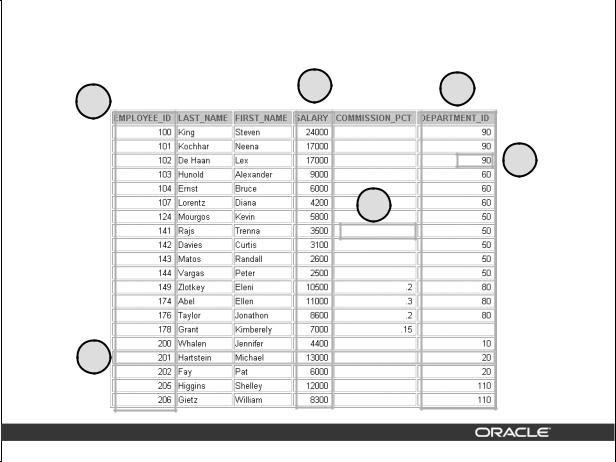
Relational Database Terminology
3 |
4 |
2 |
|
6
5
1
I-19 |
Copyright © Oracle Corporation, 2001. All rights reserved. |
Terminology Used in a Relational Database
A relational database can contain one or many tables. A table is the basic storage structure of an RDBMS. A table holds all the data necessary about something in the real world, such as employees, invoices, or customers.
The slide shows the contents of the EMPLOYEES table or relation. The numbers indicate the following:
1. A single row or table representing all data required for a particular employee. Each row in a table should be identified by a primary key, which allows no duplicate rows. The order of rows is insignificant; specify the row order when the data is retrieved.
2.A column or attribute containing the employee number. The employee number identifies a unique employee in the EMPLOYEES table. In this example, the employee number column is designated as the primary key. A primary key must contain a value, and the value must be unique.
3.A column that is not a key value. A column represents one kind of data in a table; in the example, the salary of all the employees. Column order is insignificant when storing data; specify the column order when the data is retrieved.
4.A column containing the department number, which is also a foreign key. A foreign key is a column that defines how tables relate to each other. A foreign key refers to a primary key or a unique key in the same table or in another table. In the example, DEPARTMENT_ID uniquely identifies a department in the DEPARTMENTS table.
5.A field may have no value in it. This is called a null value. In the EMPLOYEES table, only employees who have a role of sales representative have a value in the COMMISSION_PCT (commission) field.
6.A field can be found at the intersection of a row and a column. There can be only one value in it.
Introduction to Oracle9i: SQL Basics I-19

Relational Database Properties
A relational database:
•
•
•
Can be accessed and modified by executing structured query language (SQL) statements
Contains a collection of tables with no physical pointers
Uses a set of operators
I-20 |
Copyright © Oracle Corporation, 2001. All rights reserved. |
Properties of a Relational Database
In a relational database, you do not specify the access route to the tables, and you do not need to know how the data is arranged physically.
To access the database, you execute a structured query language (SQL) statement, which is the American National Standards Institute (ANSI) standard language for operating relational databases. The language contains a large set of operators for partitioning and combining relations. The database can be modified by using the SQL statements.
Introduction to Oracle9i: SQL Basics I-20
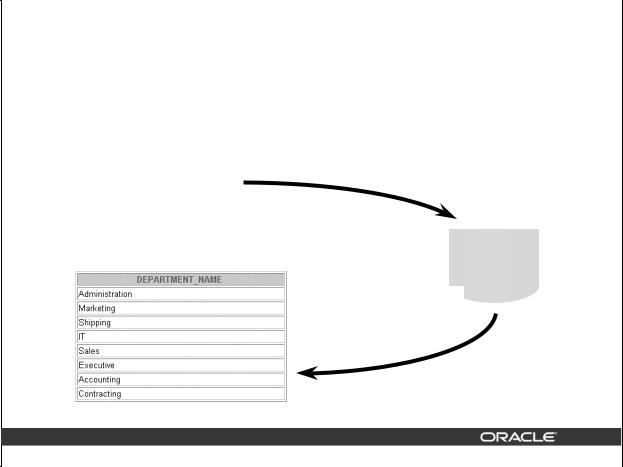
Communicating with a RDBMS
Using SQL
SQL statement |
|
|
|
|
is entered. |
Statement is sent to |
|||
|
|
|||
|
SELECT department_name |
|
Oracle Server. |
|
|
FROM departments; |
|
|
|
|
|
|
|
|
|
|
|
|
|
|
|
|
|
|
|
|
|
|
|
|
|
|
|
|
Oracle
 server
server
I-21 |
Copyright © Oracle Corporation, 2001. All rights reserved. |
Structured Query Language
Using SQL, you can communicate with the Oracle server. SQL has the following advantages:
•Efficient
•Easy to learn and use
•Functionally complete (With SQL, you can define, retrieve, and manipulate data in the tables.)
Introduction to Oracle9i: SQL Basics I-21
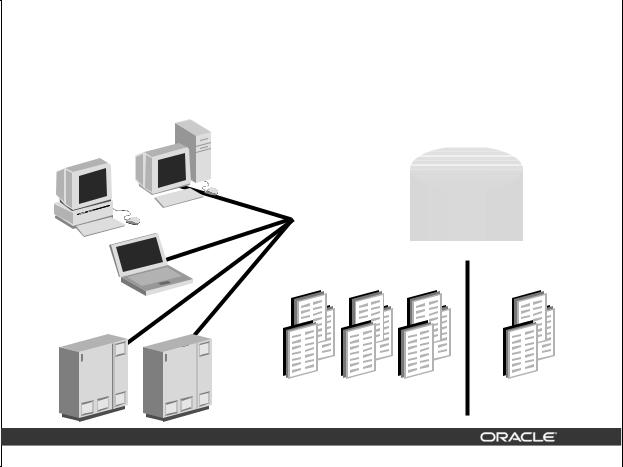
Relational Database Management System
Oracle
server
|
|
|
|
|
|
|
|
|
|
|
|
|
|
|
|
|
|
|
|
|
|
|
|
|
|
|
|
|
|
|
|
|
|
|
|
|
|
|
|
|
|
|
|
|
|
|
|
|
|
|
|
|
|
|
|
|
|
|
|
|
|
|
|
|
|
|
|
|
|
|
|
|
|
|
|
|
|
|
|
|
|
|
|
|
|
|
|
|
|
|
|
|
|
|
|
|
|
|
|
|
|
|
|
|
|
|
|
|
|
|
|
|
|
|
|
|
|
|
|
|
|
|
|
|
|
|
|
|
|
|
|
|
|
|
|
|
|
|
|
|
|
|
|
|
|
|
|
|
|
|
|
User tables |
|
|
|
|
|
Data |
||||||
|
|
|
|
|
|
|
|
|
|
dictionary |
||||
I-22 |
Copyright © Oracle Corporation, 2001. All rights reserved. |
|
|
|
|
|
|
|
|
|||||
Relational Database Management System
Oracle provides a flexible RDBMS called Oracle9i. Using its features, you can store and manage data with all the advantages of a relational structure plus PL/SQL, an engine that provides you with the ability to store and execute program units. Oracle9i also supports Java and XML. The Oracle server offers the options of retrieving data based on optimization techniques. It includes security features that control how a database is accessed and used. Other features include consistency and protection of data through locking mechanisms.
The Oracle9i server provides an open, comprehensive, and integrated approach to information management. An Oracle server consists of an Oracle database and an Oracle server instance. Every time a database is started, a system global area (SGA) is allocated, and Oracle background processes are started. The system global area is an area of memory used for database information shared by the database users. The combination of the background processes and memory buffers is called an Oracle instance.
Introduction to Oracle9i: SQL Basics I-22
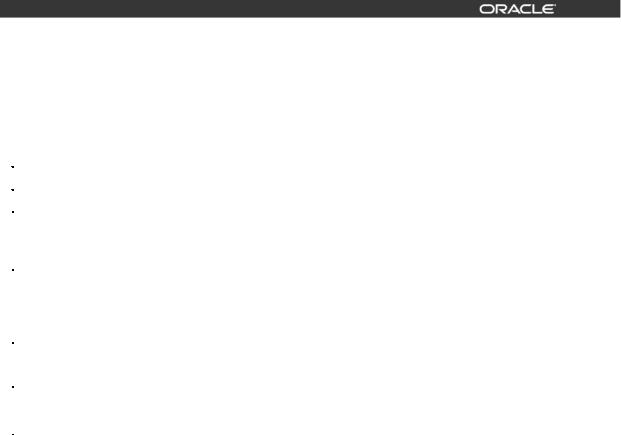
|
|
|
SQL Statements |
||
|
|
|
|
|
|
|
|
|
|
|
|
|
|
SELECT |
Data retrieval |
|
|
|
|
|
|
|
|
|
|
|
|
|
|
|
|
INSERT |
|
|
|
|
|
UPDATE |
Data manipulation language (DML) |
|
|
|
|
DELETE |
|
|
|
|
|
MERGE |
|
|
|
|
|
|
|
|
|
|
|
CREATE |
|
|
|
|
|
ALTER |
Data definition language (DDL) |
|
|
|
|
DROP |
|
|
|
|
|
RENAME |
|
|
|
|
|
TRUNCATE |
|
|
|
|
|
|
|
|
|
|
|
COMMIT |
|
|
|
|
|
ROLLBACK |
Transaction control |
|
|
|
|
SAVEPOINT |
|
|
|
|
|
|
|
|
|
|
|
GRANT |
|
|
|
|
|
REVOKE |
Data control language (DCL) |
|
|
|
|
|
|
|
|
|
|
|
|
|
|
I-23 |
|
Copyright © Oracle Corporation, 2001. All rights reserved. |
|||
|
|
|
|
|
|
SQL Statements
Oracle SQL complies with industry-accepted standards. Oracle Corporation ensures future compliance with evolving standards by actively involving key personnel in SQL standards committees. Industry-accepted committees are the American National Standards Institute (ANSI) and the International Standards Organization (ISO). Both ANSI and ISO have accepted SQL as the standard language for relational databases.
Statement |
Description |
|
|
SELECT |
Retrieves data from the database |
|
|
INSERT |
Enters new rows, changes existing rows, and removes unwanted rows |
UPDATE |
from tables in the database, respectively. Collectively known as data |
DELETE |
manipulation language (DML). |
MERGE |
|
CREATE |
Sets up, changes, and removes data structures from tables. Collectively |
ALTER |
known as data definition language (DDL). |
DROP |
|
RENAME |
|
TRUNCATE |
|
COMMIT |
Manages the changes made by DML statements. Changes to the data can |
ROLLBACK |
be grouped together into logical transactions. |
SAVEPOINT |
|
GRANT |
Gives or removes access rights to both the Oracle database and the |
REVOKE |
structures within it. Collectively known as data control language |
|
(DCL). |
Introduction to Oracle9i: SQL Basics I-23
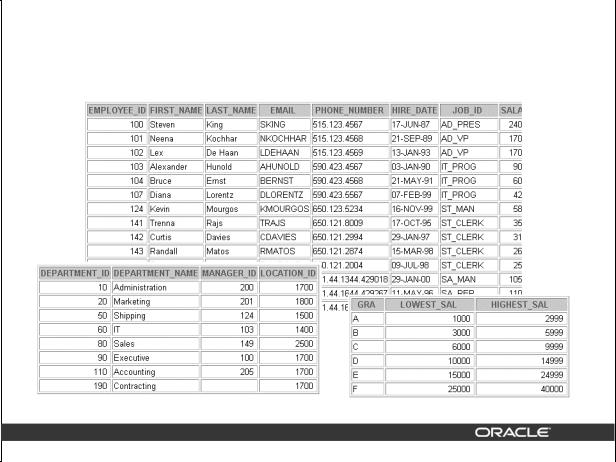
Tables Used in the Course
EMPLOYEES
|
DEPARTMENTS |
JOB_GRADES |
I-24 |
Copyright © Oracle Corporation, 2001. All rights reserved. |
|
Tables Used in the Course
The following main tables are used in this course:
•EMPLOYEES table, which gives details of all the employees
•DEPARTMENTS table, which gives details of all the departments
•JOB_GRADES table, which gives details of salaries for various grades
Note: The structure and data for all the tables are provided in Appendix B.
Introduction to Oracle9i: SQL Basics I-24

Summary
•The Oracle9i Server is the database for Internet computing.
•Oracle9i is based on the object relational database management system.
•Relational databases are composed of relations, managed by relational operations, and governed by data integrity constraints.
•With the Oracle Server, you can store and manage information by using the SQL language and PL/SQL engine.
I-25 |
Copyright © Oracle Corporation, 2001. All rights reserved. |
Summary
Relational database management systems are composed of objects or relations. They are managed by operations and governed by data integrity constraints.
Oracle Corporation produces products and services to meet your relational database management system needs. The main products are the Oracle9i Database Server, with which you can store and manage information by using SQL, and the Oracle9i Application Server with which you can run all of your applications.
SQL
The Oracle Server supports ANSI standard SQL and contains extensions. SQL is the language used to communicate with the server to access, manipulate, and control data.
Introduction to Oracle9i: SQL Basics I-25
Introduction to Oracle9i: SQL Basics I-26

Writing Basic
SQL SELECT Statements
Copyright © Oracle Corporation, 2001. All rights reserved.

Objectives
After completing this lesson, you should be able to do the following:
•
•
•
List the capabilities of SQL SELECT statements
Execute a basic SELECT statement
Differentiate between SQL statements and iSQL*Plus commands
1-2 |
Copyright © Oracle Corporation, 2001. All rights reserved. |
Lesson Aim
To extract data from the database, you need to use the structured query language (SQL) SELECT statement. You may need to restrict the columns that are displayed. This lesson describes all the SQL statements needed to perform these actions.
You may want to create SELECT statements that can be used more than once. This lesson also covers the iSQL*Plus environment where you execute SQL statements.
Note: iSQL*Plus is new in the Oracle9i product. It is a browser environment where you execute SQL commands. In prior releases of Oracle, SQL*Plus was the default environment where you executed SQL commands. SQL*Plus is still available and is described in Appendix C.
Introduction to Oracle9i: SQL Basics 1-2
